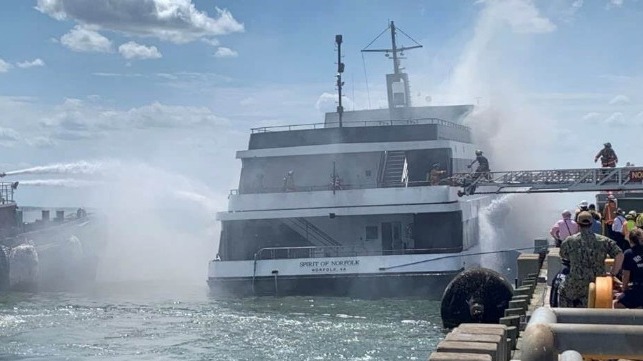NTSB: Modern Safety Systems Could Have Halted Fire on Spirit of Norfolk

The National Transportation Safety Board has completed its investigation into the fire aboard the harbor tour vessel Spirit of Norfolk, and it has concluded that flammable material stowed near an exhaust pipe likely started the blaze. The outcome was driven by other factors, the agency said - including the lack of a fixed firefighting system and ventilation dampers, which were not required by regulation for the small vessel.
On the morning of June 7, 2022, the Spirit of Norfolk departed her pier with a newly-hired captain at the helm. She had 91 passengers and 17 crewmembers aboard for a two-hour cruise.
At 1159 hours, as the captain began to make a turn to begin the return leg of the trip, the port throttle lost its connection to the port engine and stopped responding. He asked a crewmember to check the engine room, but soon noticed smoke coming from the port side engine room ventilation opening. He called the Coast Guard at 1204, and a major rescue operation was launched to get everyone off the boat.
The crew could not enter the engine room because of thick smoke, so they closed the watertight door, shut off fuel supply valves, and shut down the engine room ventilation fan. The engine room vents were not fitted with fire dampers, so there was no way to shut off natural airflow, and air continued to enter the compartment throughout the response.
Multiple good samaritan vessels responded to the emergency, including 13 tugboats and another small passenger vessel, the Victory Rover. The tug Condor held Victory Rover in place against Spirit of Norfolk's port side, and all passengers safely transferred over to the smaller passenger vessel. The captain was last off the boat after making a final sweep.
The still-burning Spirit of Norfolk was towed to a nearby berth at Naval Station Norfolk for pierside firefighting efforts, and it arrived after 1300. Shoreside firefighting teams and tugs sprayed water into the engine room through the ventilation openings in hopes of combating the fire.
At about 1430, a four-man attack team made up of City of Norfolk and U.S. Navy firefighters went aboard the vessel to spray foam into the engine room. They failed to find the escape scuttle, which they had been instructed to use for access. In an apparent communication breakdown, the attack team opened the main watertight hatch to the engine compartment instead. The hatch door "exploded" open from the force of the accumulated firefighting water behind it, trapping one man behind the hatch and causing the vessel to list to port as the weight of thousands of gallons of water shifted.
A tug held the listing tour boat against the pier to help keep it from capsizing while the firefighting team evacuated. They got off the boat, but could not close the engine room hatch behind them before they left, and this "allowed the fire to spread" to the rest of the vessel, NTSB concluded. (Personnel from the firefighting teams and the command structure declined to talk to NTSB about the details of this operation.)
At about 2000, the Coast Guard established a broader unified command and recommended that no more firefighting water be added to the vessel's interior. Boundary cooling and dewatering continued, but the fire continued to burn until the morning of June 11, four days after it started. The vessel was written off as a total loss at a cost of $5 million.
Firefighting system shortcomings
Based on an analysis of pre-accident survey information and burn patterns in the engine room, NTSB concluded that the fire likely started in a collection of combustible materials which had been stored next to the port side generator exhaust pipe.
Contributing factors to the fire's spread included a lack of fire detection and fixed firefighting systems in the engine room; these were not required aboard Spirit of Norfolk because of her age and steel hull, which qualified her for a grandfather clause for Subchapter K passenger vessels.
Engine rooms are the source of about three-quarters of all small passenger vessel fires, according to NTSB. However, there are more than 100 passenger vessels that are currently exempt from Subchapter K's engine room fire detection and fixed firefighting systems because they 1) began operation before March 10, 1996, and 2) have steel or aluminum hulls.

that matters most
Get the latest maritime news delivered to your inbox daily.
In a statement, the NTSB called on the Coast Guard to remove this grandfather clause and require these older vessels to install fire detection and fire suppression systems in the engine room - or at minimum, to require fire-detection alone. NTSB noted that it first asked the USCG to require these upgrades for small passenger vessels in 2007, but the Coast Guard declined twice because the proposal did not pass a cost-benefit analysis test.
"Had the Spirit of Norfolk been equipped with a fire extinguishing system to protect its engine room, the fire likely would have been quickly extinguished and the casualty mitigated," NTSB reasoned. "The exemption . . . presents an increased risk of harm from an engine room fire to passengers and crewmembers."
